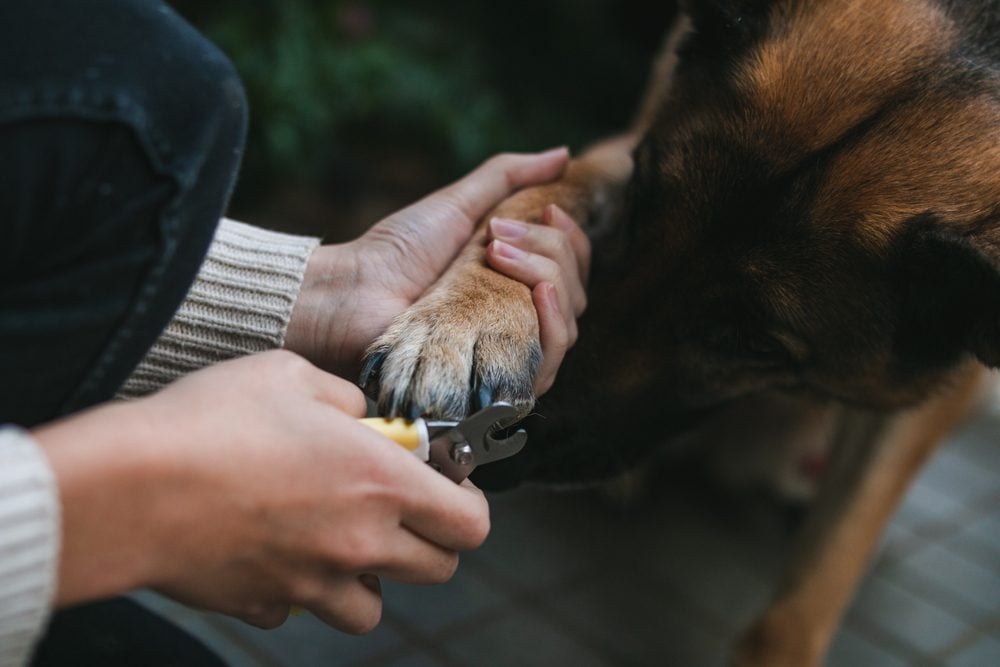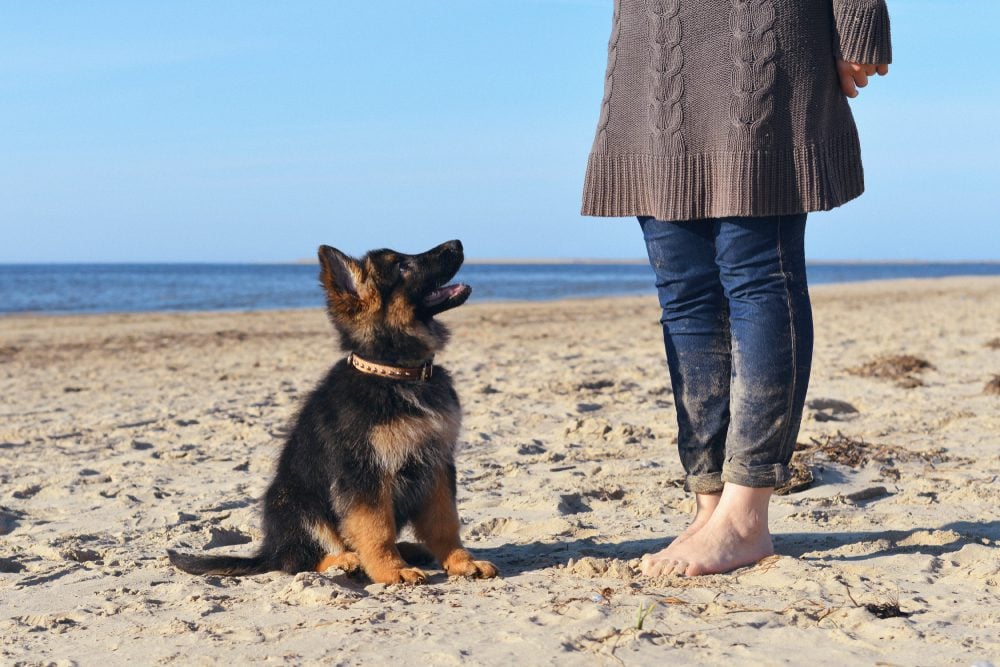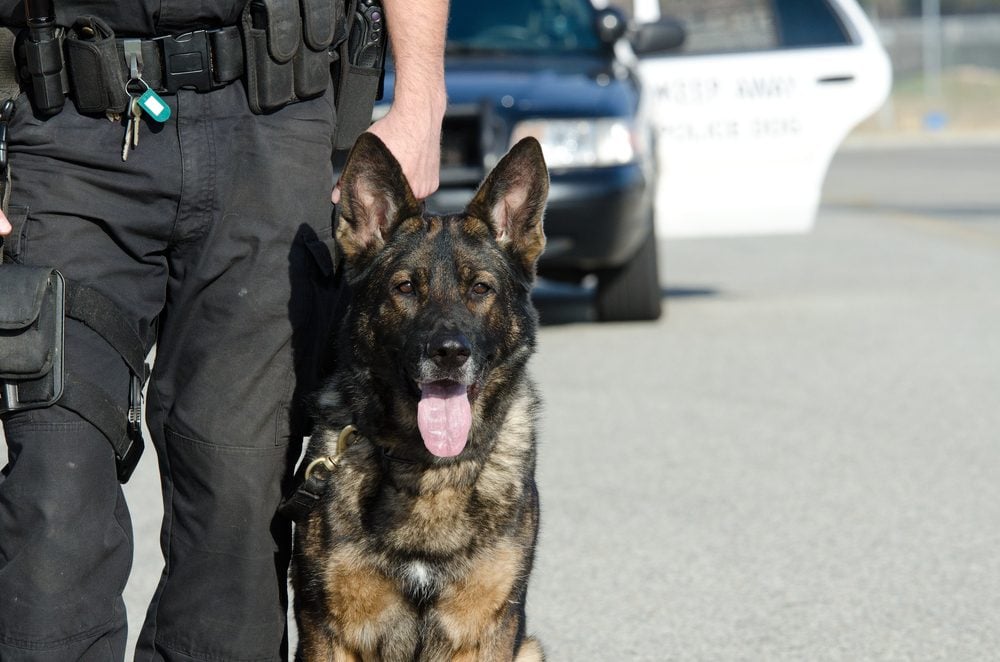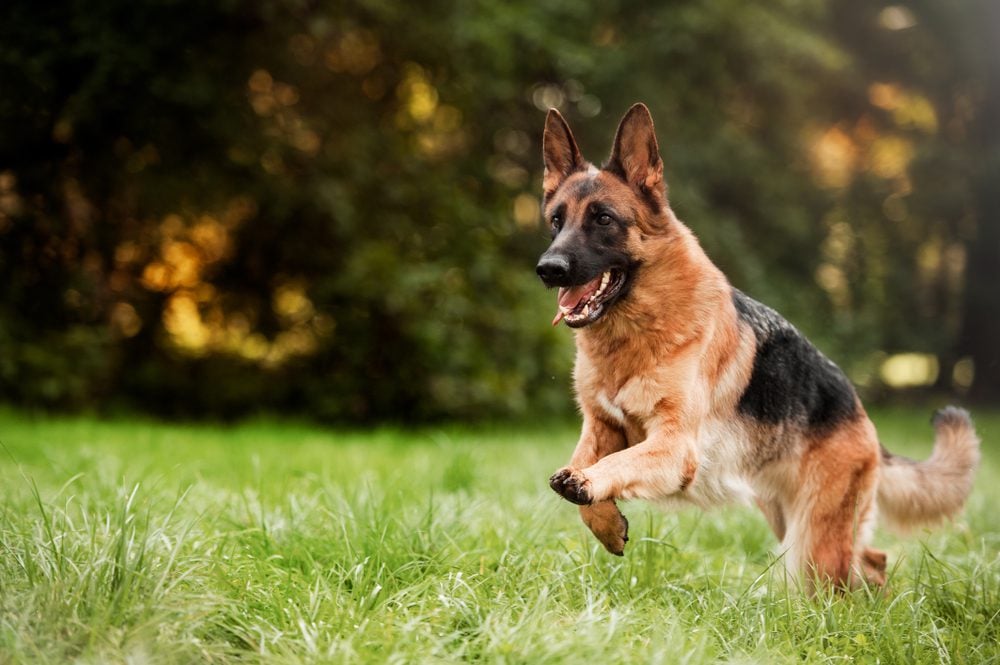German shepherds are the 3rd most popular breed in the US for a reason: they are loyal, courageous, and extremely intelligent. They make phenomenal family companions, and they’re also renowned for being the perfect working dog – they excel at virtually any task thrown at them, whether agility, tracking, or intensive police work.
If you’re welcoming a German shepherd into your home, you’ll no doubt be wanting to give them the best start at life. In this article, we’ll cover everything you need to know to do exactly that, from socialization to training that takes into account their qualities. We’ll then finish up with some effective German shepherd training tips.
German Shepherd Characteristics and Temperament
Think of a German shepherd. The first image that probably enters your mind is one working as a police dog protecting their partner from harm’s way or chasing down criminals with determination and speed.
And it’s no surprise why. German shepherds have long been considered the best police dogs out there, thanks to their loyalty, bravery, and ability to stay calm under pressure.
These same attributes make them perfect family companions. They will protect their owner and cherish every moment with them. Their gentle and sensitive demeanor also makes them great around kids too.
That said, keep in mind that German shepherds are working dogs through and through. They require a lot of exercise and mental stimulation to be truly happy. If they don’t get enough of either of these things, it’s almost a given that they’ll turn to more “unsavory” ways to release their energy and keep themselves entertained!
Is a German Shepherd Easy to Train?
German shepherds are one of the smartest dog breeds in the world. Couple their intelligence with their eager-to-please personality, and you’ve got a highly trainable pooch that can pick up virtually any command. They are even perceptive and intuitive, which further helps them excel at training.
However, German shepherds do need a firm and assertive leader. While they learn commands quickly, they’ll pick up bad habits equally fast if given the opportunity to do so.
Initially developed to be herding dogs that could protect livestock, they also tend to have a high guarding instinct. It’s important not to encourage guarding behavior during training, as this could lead them to become overprotective. In fact, this is another reason why German shepherds need a strong leader: if they feel you lack leadership, they will see it as their job to protect you at all times.
Of course, proper socialization and training, which we go over below, will ensure your German shepherd’s protective nature stays at a healthy level.
German Shepherd Training: What Training Approach?



The best and most effective training approach out there is positive reinforcement, or as it’s better known: reward-based training. Positive reinforcement involves encouraging your dog to repeat the desired behavior by rewarding them with something they highly value, like treats or toys.
You should always avoid using punishment-based measures. These measures do not truly tackle the bad behavior – they only suppress it, and they typically just leave your dog confused about what is being asked of them.
Punishment-based measures also often do more harm than good. Studies have shown that dogs trained with correction and the use of aversives are more likely to develop aggressive and destructive tendencies.
While avoiding this training approach applies to all dogs, it’s especially the case for German shepherds. Although they may look tough, they are gentle giants at heart. They are extremely sensitive, and will not respond to any sort of punishment well.
When Should the Training Process Begin?
The training (and socialization) process should start as soon as your puppy comes home. This is because the first 16 weeks are the critical socialization period of their life, where they are less fearful and more open to new things.
If you leave their socialization or training too late, it drastically increases their chances of developing behavioral problems in adulthood.
German Shepherd Training: The First Few Weeks
Training a German shepherd puppy can be overwhelming – if you don’t know where to start. Here, we’ll guide you through the process and go over everything you should work on with your puppy in the first few weeks, from potty training and crate training to socialization and obedience training.
Socializing a German Shepherd
Socialization is the process of exposing your dog to new people, environments, and situations in a positive manner. This helps them become more confident and accustomed to the world around them.
With German shepherds, it’s especially vital you get them accustomed to people and other animals; this will help curb their high guarding drive and ensure they know what’s dangerous and what isn’t.
Tips for How to Socialize Effectively
Here, we’ll quickly give a rundown of some key socialization tips. For further guidance, we advise checking out the American Kennel Club’s (AKC) in-depth guide.
Slow and steady
Socialization is a lengthy process. It’s important to be patient with your pup and take it at their pace.
When you introduce them to something new for the first time, make sure you do so in a way that’s not overwhelming. For example, if you want to introduce your German shepherd pup to other dogs, you wouldn’t take them to a park where there are dozens upon dozens of dogs, many of which could be unleashed or even aggressive. Instead, you would first introduce them to a dog that’s leashed and well-mannered, ideally from some distance.
How to make experiences positive
Whenever you introduce your German shepherd to something new, make sure to give them puppy-friendly treats and praise. This will help them to associate whatever they’re being exposed to with a pleasurable experience.
You should also ensure you’re not stressed or anxious when socializing your pup. Dogs are attuned to our feelings, and if they detect negative emotions from you, they’ll take that as a sign they should be feeling that way as well.
If your pup starts to get nervous around something, quickly redirect their attention and move away. Then, spend some time playing with solo and give them treats. When your pup is feeling at ease again, introduce them to whatever they were nervous around once more, but this time from a greater distance.
Socialization schedule
A socialization schedule is a detailed list that includes everything you should be exposing your pup to. This helps you stay on track and ensures you don’t forget anything.
While you can make your own, we recommend using this comprehensive socialization schedule. It goes into phenomenal detail and lists exposure experiences most wouldn’t even think of, like trucks backing up and people in uniform.
Puppy classes
Puppy classes allow your German shepherd to be exposed to other dogs and new people in a safe and secure environment. These classes can also help with training; your companion will be taught basic commands, and many help to prevent (or tackle) behavioral issues like resource guarding.
Studies have even shown that regular puppy classes can lessen anxiety, aggression, and stress in dogs.
Grooming
Don’t forget to prepare your pup for grooming – make it a habit to touch their paws, nails, mouth, and ears (including inside the ear). Once your pup is confident with you touching them in these areas, you can then gradually introduce the brush and clippers. Of course, don’t forget to expose them to water and bathing too!



Crate Training
A common misconception is that crating your dog is equivalent to keeping them in a cage. However, if your German shepherd is properly crate trained and the crate itself is not misused, the crate will likely become their favorite spot in the house. This is because the crate becomes their “comfy den,” where they can feel safe and secure.
Crate training can even help with potty training since dogs by instinct are reluctant to do their business where they rest.
For guidance on how to crate train your puppy, check out our dedicated guide. Also, be aware that German shepherds grow to a rather large size (22 to 26 inches tall) – we recommend investing in an adjustable crate that can grow with them.
Potty Training
You should also begin potty training your German shepherd as soon as possible. We have a guide that covers this too, which you can find here.
Basic Obedient Training
Next up, you’ll want to teach your German shepherds all the basic commands, like “sit,” “lie down” and “stay.” Basic obedience training makes managing their behavior infinitely easier, and commands like “come” and “stay” help to ensure their safety.
Keep in mind that most puppies won’t pick up these commands straight away. For some, it could even take several weeks. That said, German shepherds are exceptionally smart and eager to learn, so they do tend to pick things up at a pretty fast rate.
If you feel your shepherd is nailing the basics quickly, don’t be afraid to explore new things with them and introduce new commands – they’ll no doubt love the challenge!
Sit
“Sit” is the first command you should begin with. It’s easy to teach, convenient, and paves the way for them to learn other commands, like “lie down” and “stay.”
- When your German shepherd is standing up, hold a treat in front of their nose.
- Slowly move the treat over their head; they will move their head to keep their eyes on the treat.
- As they do this, their body will naturally end up in a sitting position.
- Once your shepherd is in the sitting position, reward them with the treat.
- Repeat this process until they catch on and begin to sit for longer durations.
- Now, incorporate the cue word “sit” and your desired hand gesture.



Lie Down
Next up is another classic: “lie down.” To teach your German shepherd this command, they’ll need to know “sit.”
- Ask your shepherd to sit while holding a treat.
- Hold the treat in front of their nose.
- Using the treat, gradually lure their nose down to their front paws. This motion should encourage your shepherd to lie down.
- As soon as they lie down, give them the treat and praise them. Initially, you can also give them the treat if they exhibit behavior which is close to lying down.
- If your pup stands up during this process, start from the beginning.
- Repeat the steps above until your German shepherd is lying down consistently.
- Bring in the verbal cue “down” and your gesture of choice.
Stay
Teaching “stay” can be a little more time-consuming, but it’s a must for your shepherd’s safety. The AKC has a really useful step-by-step guide on how to effectively teach your puppy the “stay” command.
Recall
Recall involves teaching your German shepherd to consistently come when called. Recall can be quite difficult to teach to a puppy – their curious nature means they easily get distracted!
However, starting recall training early will build the foundations for a reliable recall. Reward-based dog trainer Zak George has a great video guide on how to teach your dog to come when called.
Other Commands
While we’ve discussed the key basics, there are several more commands you can teach your German shepherd. Here, we’ve collected some of them for you to explore. While we don’t go over how to train all each one in detail, our training resources we’ve gathered below definitely cover how to break them down into teachable commands.
- Backwards
- Bow
- Crawl
- Fetch
- Go To Bed
- High Five
- Kiss
- Leave it
- Paw
- Pick Up Toys
- Play Dead
- Put Toys Away
- Quiet
- Ring Bell
- Roll Over
- Shake
- Spin
- Stand Up
- Take Gently
- Weave
Fading the Lure
Whenever your German shepherd has mastered a new command, don’t forget to fade the lure. Otherwise, they won’t perform the command for you without an incentive.
Fading the lure means fading out the use of treats – or whatever you use to lure the desired behavior. It involves gradually reducing the number of times you reward the behavior. You can find more information about this method here.
Leash Training
If you want your German shepherd to have the best “walkies” of their life, you’ll need to make sure they’re comfortable with the leash itself and also have good leash manners.
Getting your German shepherd accustomed to the leash is fairly simple. You simply introduce it to them gradually while rewarding them with treats.
Once your shepherd is comfortable with the leash, you can get started on training them to become a well-manned leash walker. This process involves teaching them loose leash walking and heel training, both of which we cover in our dedicated leash training guide. In the guide, we also discuss how to curb unwanted behavior like pulling or leash biting.
Dealing with Biting and Chewing
Puppies – particularly German shepherds – tend to be mouthy. However, this is not necessarily a bad thing; puppies chew to engage their senses and to gain a better understanding of the world around them. Chewing can also help them soothe teething pain.
Of course, your German shepherd should certainly not be biting you or chewing your favorite pair of socks. It’s important you teach them from the get-go that these behaviors are unacceptable. The American Society for the Prevention of Cruelty to Animals (ASPA) has a great article that covers how to effectively deal with mouthy behavior.
Tackling Separation Anxiety
German shepherds love nothing more than spending time with their owners, but unfortunately, their affectionate nature does make them more prone to separation anxiety than other breeds.
You can help to prevent your German shepherd from developing separation anxiety through early training. Gradually start leaving them alone for a few minutes, then increase to longer periods.
Other ways to tackle separation anxiety include:
- Don’t overreact when you leave home. While it can be tempting to say goodbye and make a big fuss, this will only escalate your German shepherd’s anxiety. They will come to associate the fuss with your departure and get worked up.
- Leave out long-lasting chew toys and mentally stimulating games to help keep them entertained and busy.
- Put on some classical music – research has shown it can actually help to ease stress in dogs.
- Invest in a soothing toy or anxiety-relieving treats.
- Leave out clothes that are covered in your scent. Your scent will provide your shepherd comfort and help reassure them.
- Consider a bolster bed; the high sides can help your dog feel more secure and safe.
Impulse Control
It’s also a good idea to practice impulse control with your German shepherd. The better self-control your pup has, the calmer and more patient they’ll be. It can also help to prevent them from developing bad habits.
You can make impulse control training fun for your pup by turning it into a game.
Advanced Activities German Shepherd’s Excel At



German shepherds excel at all sorts of advanced activities, including (but not limited to):
- Police Dogs: German shepherds are famous for being ideal police dogs for good reason: they’re loyal, brave and have a reliable nose. As police dogs, German shepherds provide protection, find crime scene evidence and even search for explosives.
- Service Work: German shepherds excel at all kinds of service dog work, thanks to their intelligence and eager-to-please nature. In fact, they were the first seeing-eye dogs in the United States! While German shepherds can be trained to perform virtually any service task, they are exceptionally great at grounding since they’re highly perceptive and attuned to their owner’s mood.
- Search and Rescue Work: As we mentioned above, German shepherds are great at picking up smells and identifying their source. So, it shouldn’t be a surprise that they make exceptional search and rescue dogs as well. German shepherds are also able to stay focused under pressure, allowing them to look for lost individuals no matter how stressful the situation or environment.
- Agility German shepherds consistently come out on top in agility courses. Looking at the breed standard, it’s understandable why: their gait is “outreaching, elastic, seemingly without effort, smooth and rhythmic.” Shepherds also have phenomenal endurance, and they love nothing more than honing agility-related tasks.
- Herding: While the first thing that comes to mind is the traditional collie, German shepherds are well-suited to herding too. They’re even a member of the AKC’s herding group.
Truly, German shepherds are the ideal all-around working dog!
German Shepherd Training Tips
Here are a few more tips to keep in mind when training your German shepherd.
Be Patient (Repetition Is Key)
German shepherds are intelligent dogs, but that doesn’t mean they’ll learn every command in an instant. Be patient and never take your frustration out on them. Doing so will only make things worse. They may even become fearful around you.
You should also keep in mind that puppies’ attention spans are a lot shorter. Try to keep training sessions around 5 to 10 minutes at first, and always finish up the session if they seem bored or frustrated.
Before finishing, though, make sure to end on a positive – ask your shepherd to perform a trick they already know, then reward them with praise and treats. This will ensure they maintain a positive outlook on training and don’t associate it with their boredom or frustration.
Consistency
Imagine if you were teaching a kid the alphabet. You tell them one day that the alphabet starts with “A.” Then the next day, you tell them that it actually begins with “C.” And then you change it again. And again.
It’s totally confusing (and downright frustrating). This is how it feels for your German shepherd when you tell them it’s okay to do one behavior – like sleeping on the couch – but then tell them off for that same behavior the next day. Set the ground rules and be consistent with them. The same goes for training. Be consistent when giving commands, and avoid changing up the cues.
Get the Timings Right
Timing is crucial in training. If you’re trying to reward your dog for a certain behavior, you need to do so immediately. Otherwise, they may get confused about which behavior you are rewarding.
A great way to improve your timing – and to ensure you always clearly communicate to your German shepherd – is by using a clicker.
Hiring a Dog Trainer
A dog trainer will ensure you’ve set up an effective and appropriate training plan. They can also help you tackle any pesky habits or behavioral issues your German shepherd develops.
When choosing a dog trainer, make sure to opt for one that’s qualified, uses positive reinforcement measures, and has previously worked with German shepherds. When you meet them for the first time, they should be friendly, outgoing, and more than willing to answer your questions.
Avoid any trainers that use punishment-based training methods or use words like “alpha” and “dominance.” Other warning signs to look out for include them not letting you supervise the training sessions, claiming that they’re self-taught, and promising you fast results.
Training Resources
Throughout this guide, we’ve incorporated links to useful resources, but here are a few more that will help you prepare for your German shepherd’s training.
- German shepherd breed information. Everything you need to know about your companion, including the breed’s history.
- The German Shepherd Dog Club of America (GSDCA) has a whole wealth of information. You can also discover dedicated German shepherd events.
- AKC’s dog care advice. One of the most reputable organizations out there for dog care. All advice is provided by experts.
- The German shepherd official breed standard, covering appearance, temperament, and size.
- PetMD’s vet-approved dog training guides. You can find guides for dogs of all ages about all topics, including behavior, health, and nutrition.
- VCA’s guides on puppy behavior and training. Goes into great detail about how to effectively fade lures and how much time you should be spending training your pup.
- 14 tips for managing frustration while training. This article covers self-calming strategies from deep breathing to learning your own triggers while highlighting the importance of keeping a cool head around your pup.
- Positive reinforcement-based dog trainer Zak George’s video guides. His training videos are helpful and easy to understand.
Raising a Star Pup
German shepherds are one of the easiest breeds to train, and they’re also one of the most courageous, gentle, and hardworking dogs out there. They love nothing more than pleasing their owner, and their loyalty is unrivaled.
That said, German shepherds are very “demanding” dogs. They need lots of exercise and mental stimulation, as well as a determined owner who can put them to work with confidence.
Before you go, we can’t stress this enough: remember that positive reinforcement is without a doubt the most effective training approach. Punishment-based training will never bring the best results, and these measures can be detrimental to your German shepherd’s wellbeing.
